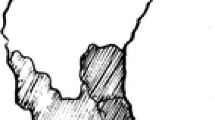Summary.
Between January 1989 and March 1997, 175 patients with traumatic shoulder dislocations were treated by conservative means (median age 41 years, 39 F, 136 M). In 78 patients (17 F, 61 M) a clinical and radiological follow up (median 50 months, range 6–106) could be obtained. Additionally, a diagnostic ultrasound was carried out in all patients. The recurrence rate in the group younger than 30 years (G < 30; n = 35) was 86 %; in the group older than 30 years (G > 30; n = 43) it was 21 % (P < 0.05). Persisting neurological deficits were found in 6 patients (8 %). According to the Rowe score, 16 patients (46 %) of the G < 30 achieved excellent or good results, in the G > 30, 29 patients (67 %). In 17 % of cases, a glenohumeral arthrosis was diagnosed be radiological means. 18 % had radiological signs of a previous fracture of the greater tuberosity. Hill-Sachs lesions were identified in 19 % of cases. Rotator cuff tears were diagnosed in 9 % by ultrasound. No relationship between the duration of immobilization and the recurrence rate was found (P = 0.95). The recurrence rate following primary shoulder dislocation depends primarily on the patients' age.
Zusammenfassung.
Im Zeitraum von Januar 1989 bis März 1997 wurden 175 Patienten mit traumatischer Schultererstluxation konservativ behandelt (Alter median 41 Jahre; 39 weiblich, 136 männlich). 78 Patienten (17 weiblich; 61 männlich) konnten nach median 50 Monaten (6–106) klinisch, radiologisch und sonographisch nachuntersucht werden. Die Rezidivrate in der Gruppe der unter Dreißigjährigen (G < 30, n = 35) lag bei 86 %, in der Gruppe der über Dreißigjährigen (G > 30, n = 43) bei 21 % (p < 0,05). Persistierende Nervenläsionen bestanden in 8 % der Fälle. Mit dem Rowe-Score erreichten in der G < 30 16 Patienten (46 %) ein sehr gutes bzw. gutes Ergebnis, in der G > 30 waren es 29 Patienten (67 %). In der radiologischen Diagnostik fanden sich in 19 % Hill-Sachs-Läsionen, in 17 % glenohumerale Arthrosen und in 18 % alte Tuberculum-majus-Frakturen. In der sonographischen Diagnostik wurden in 9 % Rotatorenmanschettenläsionen festgestellt. Die Dauer der Ruhigstellung hatte keinen Einfluß auf die Rezidivrate (p = 0,95). Die Reluxationsrate nach traumatischer Erstluxation ist in erster Linie altersabhängig.
Similar content being viewed by others
Author information
Authors and Affiliations
Rights and permissions
About this article
Cite this article
Lill, H., Verheyden, P., Korner, J. et al. Konservative Behandlung nach traumatischer Schultererstluxation?. Chirurg 69, 1230–1237 (1998). https://doi.org/10.1007/s001040050561
Issue Date:
DOI: https://doi.org/10.1007/s001040050561




